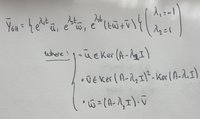Greetings. I am studying for an exam on differential equation integration techniques. I find the ODE section to be straightforward enough although i have doubts as to how to solve a particular case for systems with constant coefficients. Sorry in advance for not knowing how to program the mathematics in nicely.
So, given a homogenous ODE system in R3 satisfying
y'=Ay (where y'=dy/dt and y are vectors in 3 dimensions, and A is a constant 3x3 matrix)
•y(0)=(2,1,1)
•A=
-1,0,0
0,1,0
-1,-1,1
So, i do the following:
1) Since is is a homogenous equation with constant coefficients, the fundamental matrix (the way i call the Wronksian) will he the exponent of the matrix A times t. A is not diagonal or nilpotent, and cannot be decomposed into 2 commutative matrices, 1 diagonal and one nilpotent. Therefore we shall have to see if we can make it diagonal.
2) Find eigenvalues and eigenvectors of A. I calculate the eigenvalues to be E1=-1 (miltiplicity 1) and E2=1 (multiplicity 2), giving associated eigenvectors V1(2,0,1)(associated to E1) and V2(0,0,1) (associated to E2). The dimension of the subspace created by the eigenvectors of E2 do not match the multiplicity of the eigenvalue and therefore i conclude that this matrix is "non diagonalizable".
Here is where my issue is. Now, from the theory that I have studied i understand that, in this particular case, a base of the solution to the homogenous equation can be written thusly I amhaving trouble understanding the solution. Can i take these vectors, u v and w, to be any vectors which pertain to the nucleus of their respective applications? What doesit mean to subtract one "ker" of an application from another?
I amhaving trouble understanding the solution. Can i take these vectors, u v and w, to be any vectors which pertain to the nucleus of their respective applications? What doesit mean to subtract one "ker" of an application from another?
The solutions for each of those vectors are
u=(2,0,1)
v=(0,1,1)-(2-0-1)=(-2,1,0)
w=(4,0,1)
I notice here that u is just the eigenvector associated to E1 (obviously that by definition will pertain to the nucleus of the application (A-E1•IdentityMatrix). So, to obtain the second vector, v, am i good to just always subtract a vector pertaining to the first base? This is where I am confused.
Thank you for taking the time to read this, any help would be greatly appreciated!
So, given a homogenous ODE system in R3 satisfying
y'=Ay (where y'=dy/dt and y are vectors in 3 dimensions, and A is a constant 3x3 matrix)
•y(0)=(2,1,1)
•A=
-1,0,0
0,1,0
-1,-1,1
So, i do the following:
1) Since is is a homogenous equation with constant coefficients, the fundamental matrix (the way i call the Wronksian) will he the exponent of the matrix A times t. A is not diagonal or nilpotent, and cannot be decomposed into 2 commutative matrices, 1 diagonal and one nilpotent. Therefore we shall have to see if we can make it diagonal.
2) Find eigenvalues and eigenvectors of A. I calculate the eigenvalues to be E1=-1 (miltiplicity 1) and E2=1 (multiplicity 2), giving associated eigenvectors V1(2,0,1)(associated to E1) and V2(0,0,1) (associated to E2). The dimension of the subspace created by the eigenvectors of E2 do not match the multiplicity of the eigenvalue and therefore i conclude that this matrix is "non diagonalizable".
Here is where my issue is. Now, from the theory that I have studied i understand that, in this particular case, a base of the solution to the homogenous equation can be written thusly
 I amhaving trouble understanding the solution. Can i take these vectors, u v and w, to be any vectors which pertain to the nucleus of their respective applications? What doesit mean to subtract one "ker" of an application from another?
I amhaving trouble understanding the solution. Can i take these vectors, u v and w, to be any vectors which pertain to the nucleus of their respective applications? What doesit mean to subtract one "ker" of an application from another?The solutions for each of those vectors are
u=(2,0,1)
v=(0,1,1)-(2-0-1)=(-2,1,0)
w=(4,0,1)
I notice here that u is just the eigenvector associated to E1 (obviously that by definition will pertain to the nucleus of the application (A-E1•IdentityMatrix). So, to obtain the second vector, v, am i good to just always subtract a vector pertaining to the first base? This is where I am confused.
Thank you for taking the time to read this, any help would be greatly appreciated!


